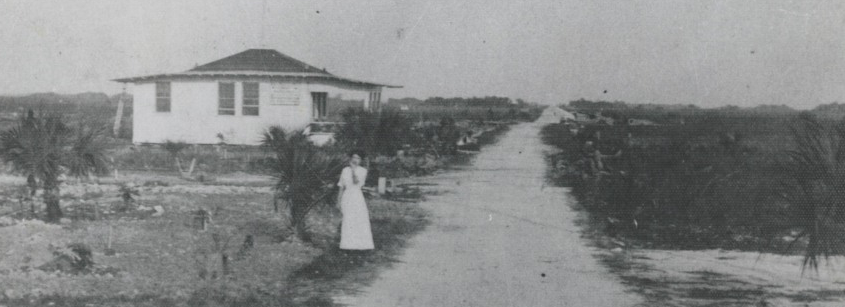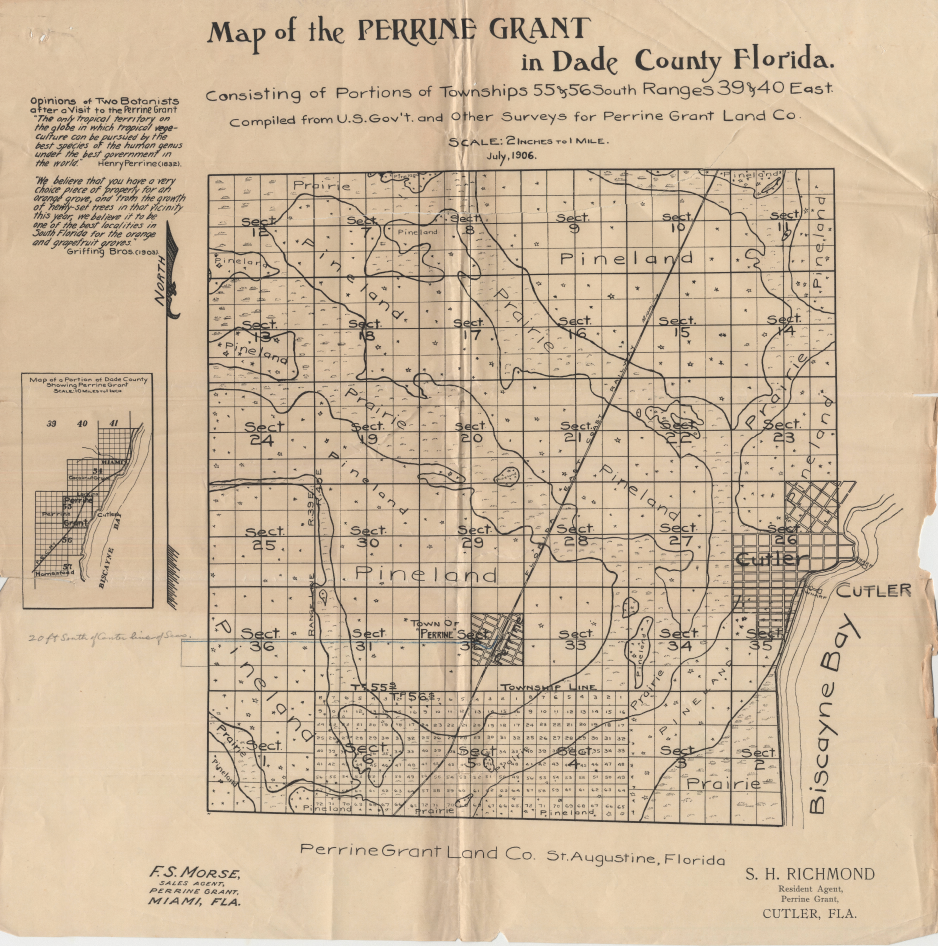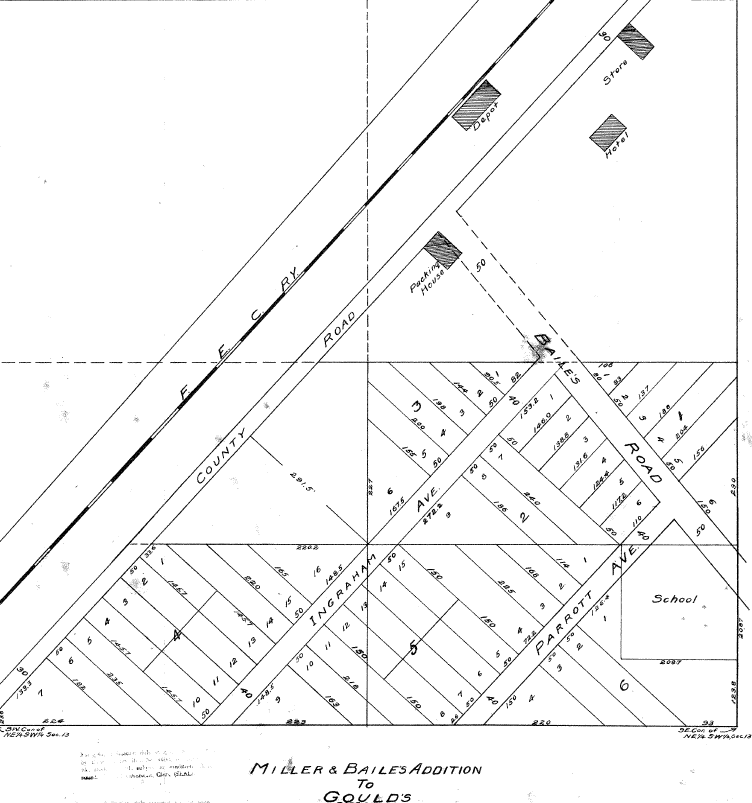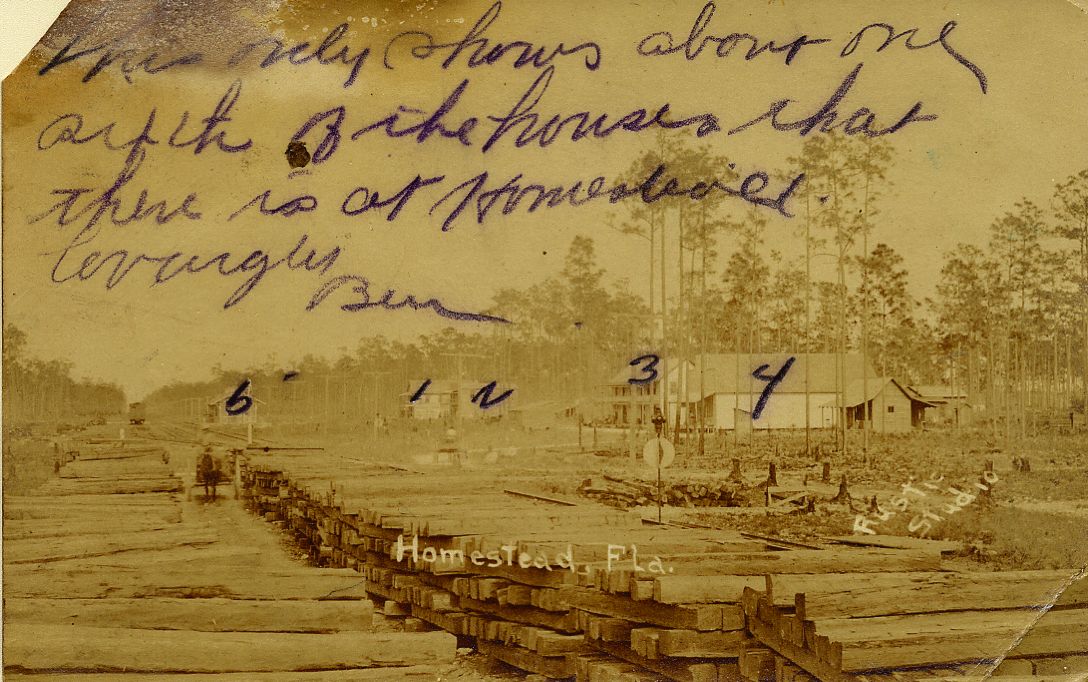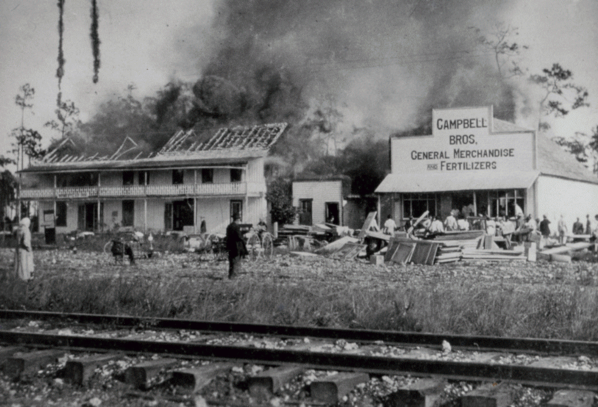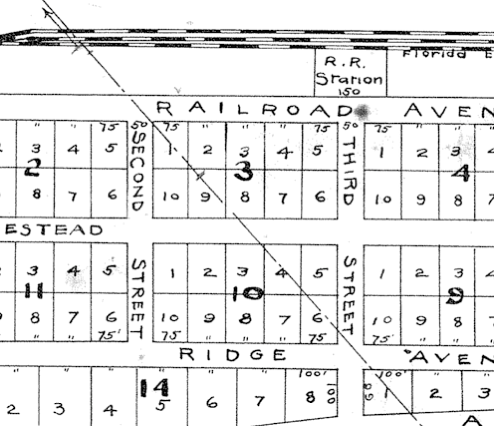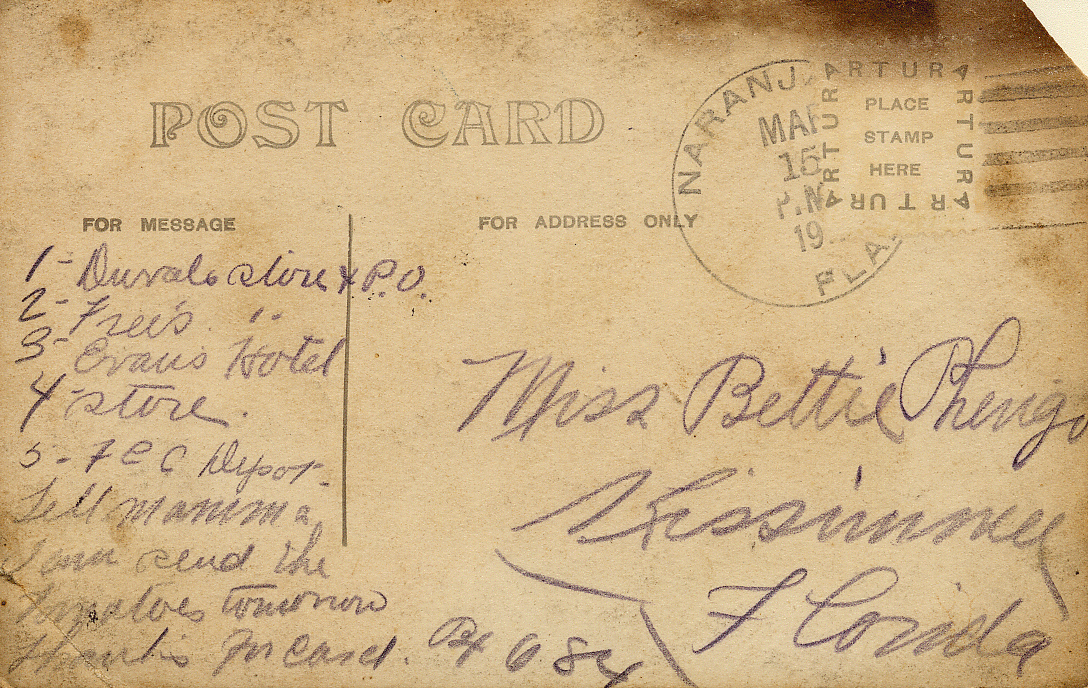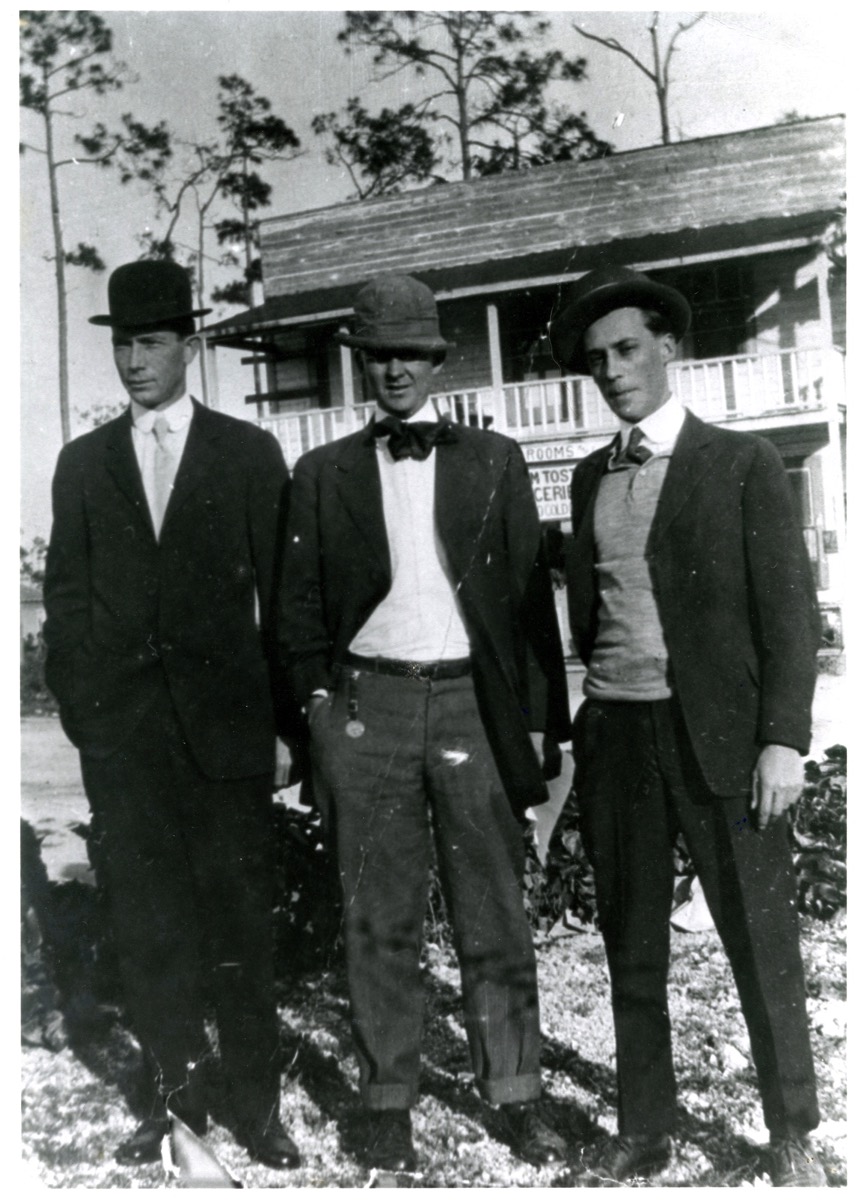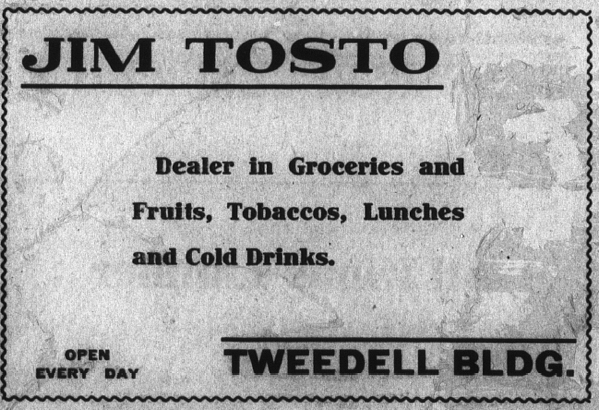by Jeff Blakley
If you grew up in Goulds or Princeton, you know where Baile’s Road is. For those who never ventured far from Homestead as a child, Baile’s Road joins U.S. 1 at about S.W. 224th St., where the NAPA store is located.
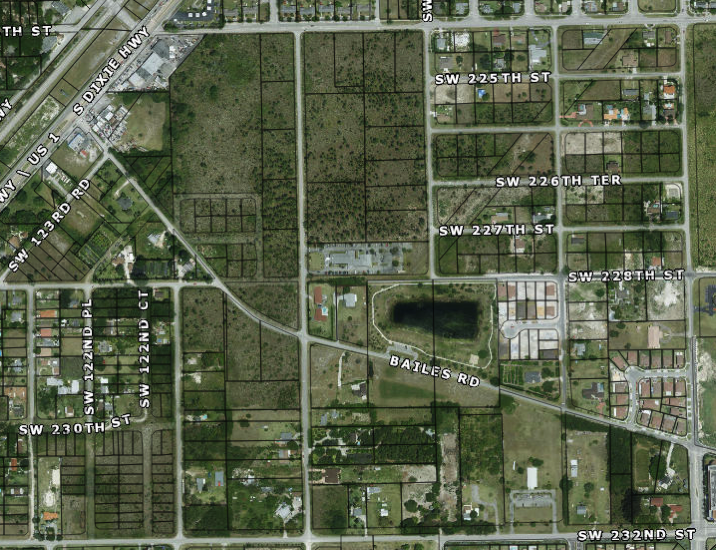
For years, I drove by the intersection and occasionally turned on to the road and ventured east but I never knew the story behind the road. A small patch of pine rockland has been preserved just east of the highway, which makes for an initial scenic drive. The road angles south and east and then merges with Silver Palm Drive before it reaches Allapattah Road.
Viewing the past from our small nuclear families in 2018 prevents us from understanding how important the network of kinship ties that governed life on the frontier in early Dade County was. In this post, I hope to show you some of those relationships as they pertain to Baile’s Road.
Baile’s Road is named after John Charles Baile, who was born on December 27, 1859 in Dayton, Ohio. He was the son of John and Sarah Lovina Eby Baile. In 1877, after his father died, his mother moved the family to Warrensburg, Missouri.1 In 1880, he, his mother and his five siblings were living in Warrensburg, Missouri.2 He still lived there 20 years later, in 1900, when he was enumerated with his wife, Rosie, 28, their daughter Hilda, 6, and their son Kenneth, 4. He was a farmer, like the vast majority of his neighbors.3 In 1902, the Johnson County Board of Equalization raised the assessed value of his farm from $3,500 to $4,500, a substantial increase.4 Baile was a successful farmer 5 and businessman who bought and sold property in the Williamsburg area. In 1907, he sold 325 acres to his younger brother, Clifton A. Baile, for $16,000.6
Also living in Warrensburg were Joseph Collins Christopher (1850-1929) and his wife, Minnie Claire. She was a sister of John Charles Baile and her husband was a wealthy real estate investor. Joseph’s brother, George R., was a blacksmith in 1870 in Coldwater, Missouri who had a combined real and personal estate valued at $4,600.7 Another person of interest in Warrensburg was Nancy Jane Baile Roop (1839-1922), the wife of Ezra Roop. In 1870, Ezra had a combined real and personal estate valued at $12,500. Nancy was the older sister of J. C. Baile and the mother of John A. Roop, born in 1866.
John Roop invested in orange groves in McMeekin, Florida, which is between Hawthorne and Interlachen, as early as 1893.8 No doubt, he lost a lot of money in the freezes of 1894-1895, when so many other men came south to establish new groves in the “frost-free” area of Dade County. In August of 1907, the Warrensburg newspaper reported that “Charley Baile and John Roop have lately returned from Florida where they invested a whole lot of money in an orange grove.”9
The first mention of J. C. Baile in Miami occurred in July of 1907, when he and his nephew, John A. Roop, registered at the San Carlos Hotel.10 That same month, they went out on a fishing trip with Smiley M. Tatum,11 one of the Tatum Bros., whose career had started when his brother, B. B. Tatum purchased The Miami Metropolis in December of 1899. Less than a month later, J. H. Tatum & Co. sold the property of Charles O. Richardson on the Miami River, known as Musa Isle, to Baile and Roop.12 Richardson, who was nearly 91 years old, sold his property for the very low price of $500. That sale caused a bit of a controversy at the time, due to allegations that Richardson had been taken advantage of.13
Baile’s brother-in-law, Joseph C. Christopher (husband of Baile’s sister Minnie) came to stay for the winter in 1908. He was a prominent businessman in his home town, but is a convert to the winter climate of Miami.14 In 1913, he and his son, who was in the wholesale grocery business in Warrensburg, purchased 2 lots with 110′ of frontage on the Miami River and planned to build a two-story reinforced concrete building on the property.15 16
J. C. Baile, who had access to a considerable amount of money, hit the ground running when he arrived in Miami. He solicited funds from Miami businessmen to build a highway from downtown Miami up through the Gen. Samuel C. Lawrence17 estate, which was three miles up the river,18 past the pumping station at the head of the Everglades and then connecting to the Allapattah Road.19
In October of 1908, the F.E.C. Hotel Electric Light department agreed to extend electric service to Lemon City. As part of that agreement, Baile, who lived in that area, agreed to furnish the poles and place them, assisted by residents of the area.20
Also in 1908, J. C. and Florence Haden of Cocoanut Grove (of Haden mango fame) worked together to send fruits and vegetables to the Michigan State Fair, held in Detroit from September 3 – 5.21 By the summer of 1909, J. C. had been appointed as one of the directors of the Subtropical Laboratory Association, which was formed to support the research station in Miami that had been supported by the U.S. Bureau of Plant Industry. 22Funding for the station had been greatly reduced in August, as the U. S. Government anticipated that the State of Florida would support the laboratory in the future. The Association provided funding for operations until Gainesville took control.23
In June of 1909, J. C. Baile, William L. Burch, and Thomas E. Cheatham (who, like Baile, was from Warrensburg, Missiouri), acquired a tract of land east of Goulds from the Model Land Company and filed for Letters Patent with the State of Florida to establish the Campo Rico Trucking Company. Burch, with 1 share, was president; Cheatham, with 111 shares, was vice-president; and Baile, with 55 shares, was the secretary and treasurer.24 William L. Burch was a typical early Miami entrepreneur who engaged in truck farming and selling real estate. He also owned a saloon and operated a number of launches which took passengers to the beach and up the Miami River to see the Everglades. In 1903, he built the launch Sallie and began making trips up the Miami River.25 26 Thomas E. Cheatham owned a tailoring business in Miami and was the brother of J. Hubbard Cheatham, a wealthy merchant. They were natives of Viriginia and had come to Miami from Bartow, Florida in 1898 to serve the needs of the Spanish-American War soldiers in town at that time, according to an article by Howard Kleinberg published in the Miami News as the “363rd in a series of articles about early Miami.”27 The Cheathams lived in South Side, which, before it was taken over by the building boom of the early 2000s, was a wealthy residential area with numerous mansions west of Brickell and south of S.W. 8th St.
By late 1909, the Campo Rico Trucking Company was advertising in the Miami Metropolis:28
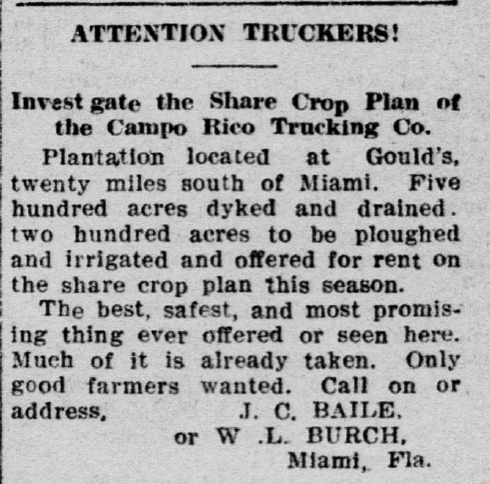
Farmers rented the land owned by J. C. Baile and his partners and grew tomatoes, cabbage, potatoes, celery, beans and other crops for the Miami market and for shipment to the North. Among the farmers were William Ira Peters, a brother of tomato king Thomas J. Peters; Leon M. Fornell, who was born in France; Anderson Lee Allen, County Commissioner from District 4 in 1908, member of the Florida Citrus Exchange and the postmaster of Goulds in 191329, who was killed in 1922 in a train/truck accident;30 Charles W. Bush and John Strange. John Strange was an iron worker from Brooklyn who quit his job on the Key West Extension after the 1906 hurricane and settled in Goulds to become a supervisor for Campo Rico. He was the Strange in the Owens and Strange subdivision in Goulds, plat book 9, page 63, platted in 1924.
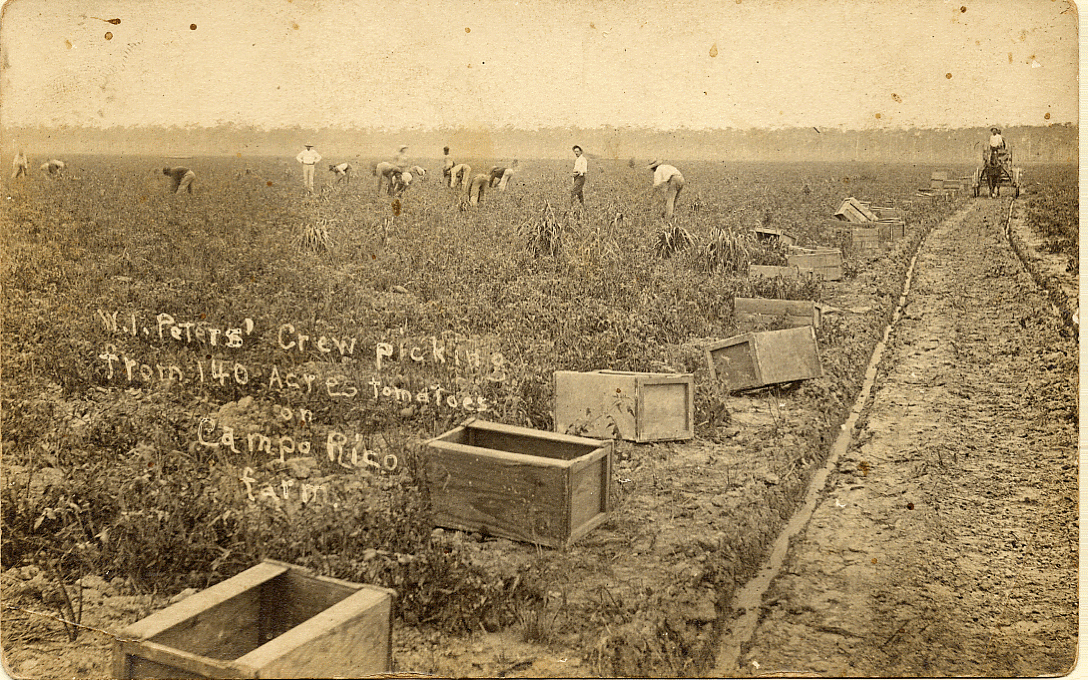
J. C. Baile built a packing house at the corner of Baile’s Road and the County Road. The road was completed by late 1910 and just waiting for the County road roller to compact the surface.31 Baile’s packing house burned down in the 1920s. The packing house is shown on this plat of Goulds, from 1912. Click on the link under the image to download a larger version:
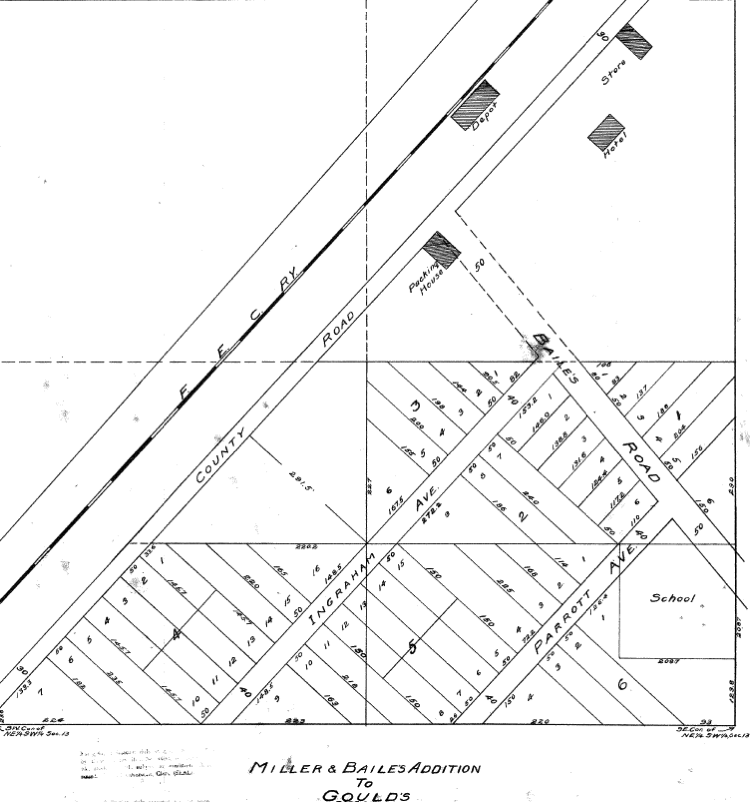
The Baile Farm was in the East Glade, between S.W. 232nd St. on the south and Black Point Creek on the north. Baile built a 1.5 mile long narrow gauge tram line before 191132 to carry the produce from the field packing house at about Allapattah Road and Silver Palm Drive to the packing house near the depot in Goulds.
This is a photograph of the packing house on Allapattah Road:
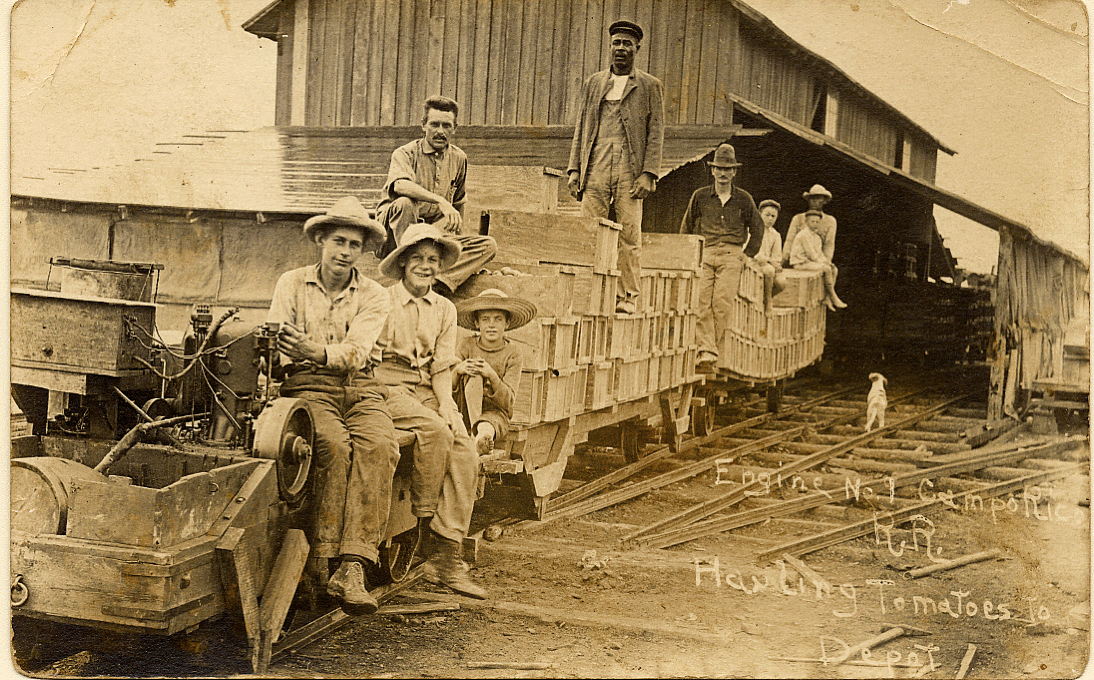
Engine No. 1 was powered by a 5 1/2 horsepower Ferro marine engine, according to the October, 1911 issue of the magazine Motor Boating.
The packing house shown in this photograph was at the intersection of U.S. 1 and Baile’s Road:
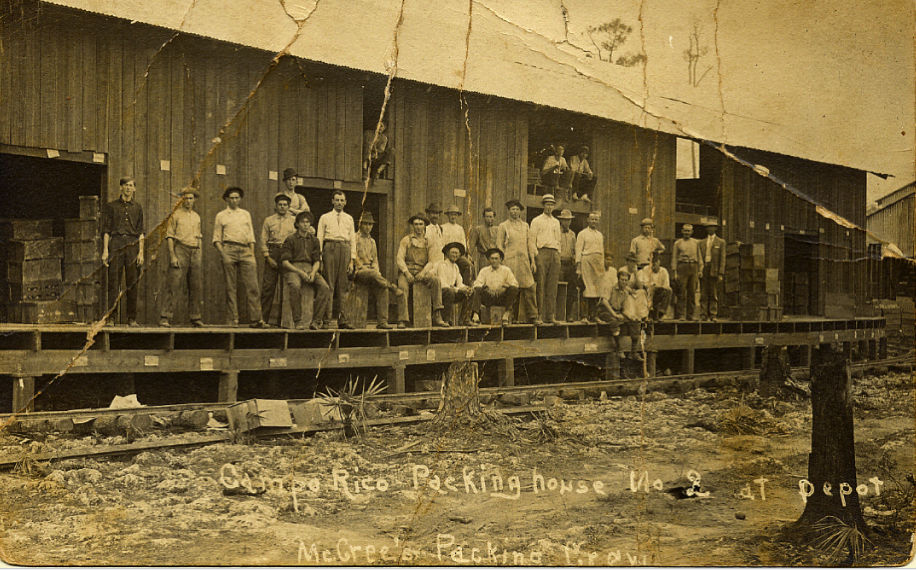
People were very resourceful in those days – this photograph shows Engine No. 2, which apparently was a converted automobile:
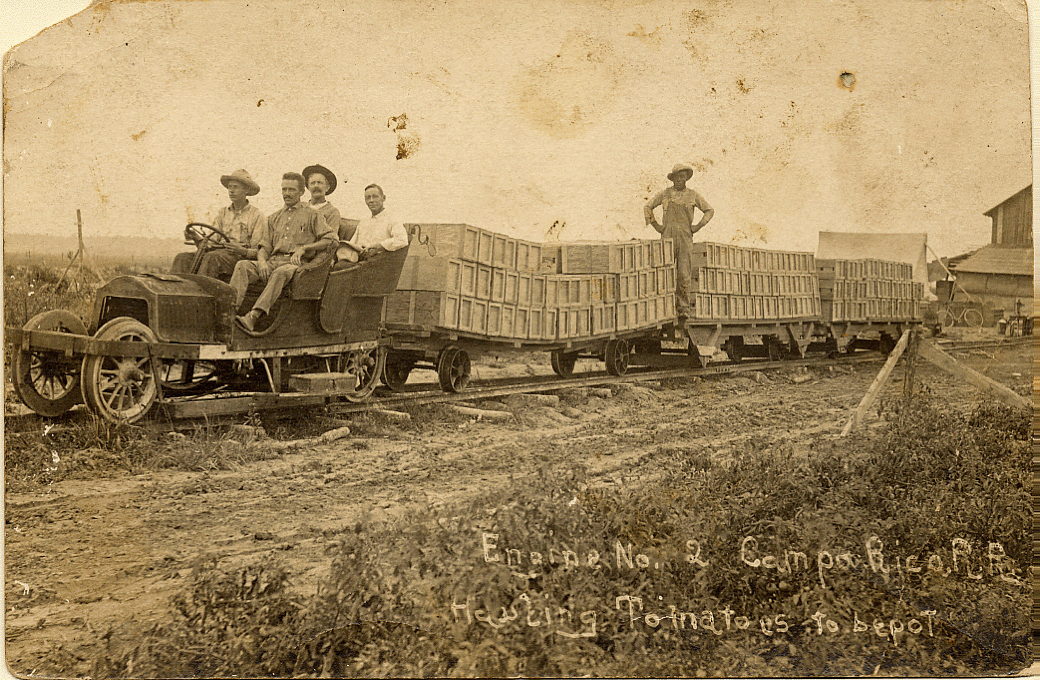
The Baile Farm struggled to be a successful farming venture. According to an article that appeared in The Country Gentleman in 1911,33 Baile had installed two drainage plants, each capable of moving 12,000 gallons of water a minute. The pumps were added after dikes on the north, east and west sides of the tract had been built in 1909. Within the tract, the Campo Rico Trucking Co. had dredged 7 miles of canals.34 That didn’t help because heavy rains flooded the land and destroyed the farmers’ crops, a lesson not lost on the Tatum Brothers, who invested heavily in digging the Florida City and North (Michigan Avenue) canals from 1912 – 1914 to drain the land that their Miami Land and Development Company owned east of their planned community, Detroit.
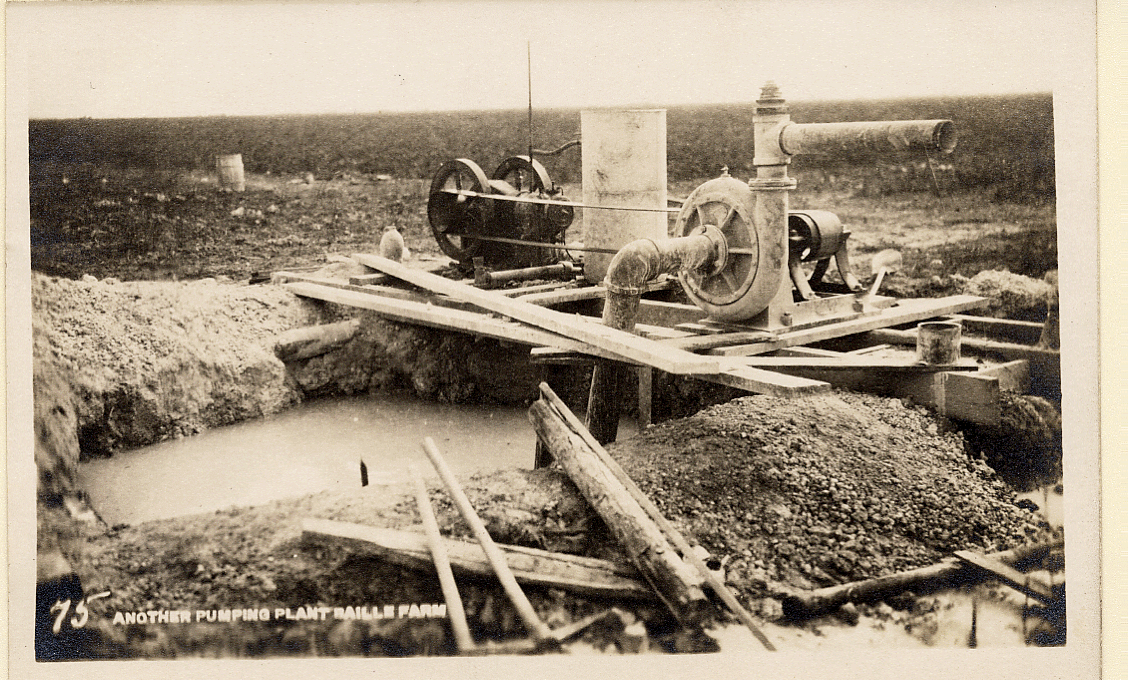
J. C. Baile was involved in many other ventures besides his farm in Goulds. He had an interest in the Biscayne Bay Company, which purchased land on Miami Beach that was later developed by Carl Fisher. As a County Commissioner, he was the prime mover behind the creation of the Goulds Drainage District, which funded the construction of the Goulds Canal. He was also in charge of the construction of what is now known as the McArthur Causeway.
Goulds, like Princeton, Naranja, Modello, Homestead and Florida City, has a very rich and complex history. This post and the two posts on Lyman B. Gould and the Beginnings of Goulds barely scratch the surface. It is not generally known, but two African-Americans, William Randolph and William Johnson, each claimed 160 acres that is now the heart of the African-American community in Goulds. There were also two other Black men, Jeff Marshalls and John Hector, who claimed homesteads just north of the Johnson and Randolph claims. Marshall’s claim was cancelled but Hector patented his 80-acre claim in 1912. Johnson and Randolph were not the first claimants for their homesteads – they picked up cancellations. Marshalls was first, but his claim was cancelled.35 Hector picked up the cancellation of George J. Sullivan’s claim. Nor is the story of what is now Cauley Square very well known. It is a puzzle to me why the history of the area between Miami and the Keys has been ignored for so many years.
______________________________________________________________
May 19, 2023: Extensively updated and revised.
